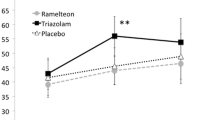Summary
Thirteen healthy subjects participated in a combined acute and subacute double-blind, crossover trial of two H1-antihistamines diphenhydramine (DPH) and temelastine (SKF) against placebo. The doses were DPH 50 mg b.d. and SKF 100 mg b.d. Objective (digit symbol substitution, flicker fusion, Maddox wing, attention, tracking, choice reaction) and subjective (visual analogue scales, side-effects on questionnaire) tests were done on Days 1, 4 and 5, on each occasion before drug intake and after 90 min and 3 h.
On Day 1 DPH caused clear sedation of unpleasant character and impaired flicker fusion, attention and digit symbol substitution. SKF shifted the VAS assessment “drowsy/alert” towards drowsiness at 90 min, without objective impairment. On Day 4 DPH reduced exophoria and impaired flicker fusion without subjective sedation. On Day 5, diazepam 0.3 mg/kg (DZ) given with the other drugs caused subjective sedation of pleasant character and impaired various functions in the objective tests. Neither SKF nor DPH increased the effects of DZ; DPH slightly counteracted the effect of DZ on exophoria. At home, SKF did not differ from placebo while DPH proved sedative. DPH did not improve sleep but caused dry mouth and blurred vision. Measurement of plasma levels of antihistamines on each test day revealed the development of tolerance to antihistamine-induced sedation. The concentration of DZ measured by bioassay was somewhat elevated in the presence of DPH. Since the majority of the performance tests were not influenced by temelastine, it appears to be an acceptable, novel H1-antihistamine for the treatment of allergic disorders.
Similar content being viewed by others
References
Abernethy DR, Greenblatt DJ (1983) Diphenhydramine determination in human plasma by gas-liquid chromatography using nitrogen-phosphorus detection: application to single low-dose pharmacokinetic studies. J Pharm Sci 72: 941–946
Aranko K, Mattila MJ, Seppälä T, Aranko S (1984) The contribution of active metabolites to the tolerance developing to diazepam in man: Relationship to bioassayed serum benzodiazepine levels. Med Biol 62: 277–284
Betts T, Markman D, Debenham S, Mortiboy D, McKevitt T (1984) Effects of two antihistamines on actual driving performance. Br Med J 288: 281–282
Bilzer W, Gundert-Remy U, Weber E (1974) Relationship between antihistaminic activity and plasma level of diphenhydramine. Eur J Clin Pharmacol 7: 393–395
Boyce MJ (1984) Effects of SK & F 93944, a new H1-antagonist on the cardiovascular response to betahistine in healthy subjects. Br J Clin Pharmacol 18: 277P-278P
Brown EA, Griffiths R, Harvey CA, Owen DAA (1986) Pharmacological studies with SK & F 93944 (temelastine), a novel histamine H1-receptor antagonist with negligible ability to penetrate the central nervous system. Br J Pharmacol 87: 569–578
Carruthers SG, Shoeman DW, Hignite CE, Azarnoff DL (1978) Correlation between plasma diphenhydramine level and sedative and anti-histamine effects. Clin Pharmacol Ther 23: 375–382
Clarke CH, Nicholson AN (1978) Performance studies with antihistamines. Br J Clin Pharmacol 6: 31–36
Cohen AF, Posner J, Ashby L, Smith R, Peck AW (1984) A comparison of methods for assessing the sedative effects of diphenhydramine on skills related to car driving. Eur J Clin Pharmacol 27: 477–482
Cohen AF, Hamilton MJ, Liao SHT, Findlay JWA, Peck AW (1985) Pharmacodynamic and pharmacokinetics of BW 825C: A new antihistamine. Eur J Clin Pharmacol 28: 197–204
Cochran WG, Cox CM (1950) Experimental design. Wiley, New York, pp 218–240
Hannington-Kiff JG (1970) Measurements of recovery from outpatient general anaesthesia with a simple ocular test. Br Med J 3: 132–135
Krause L, Shuster S (1983) Mechanism of action of antipruritic drugs. Br Med J 287: 1199–1200
Levander S, Hägemark Ö, Ståhle M (1985) Peripheral antihistamine and central sedative effects of three H1-receptor antagonists. Eur J Clin Pharmacol 28: 523–529
Linnoila M (1973) Drug effects on psychomotor skills related to driving: Interaction of atropine, glycophyrrhonium and alcohol. Eur J Clin Pharmacol 6: 107–112
Linnoila M, Mattila MJ (1973) Drug interactions on psychomotor skills related to driving: Diazepam and alcohol. Eur J Clin Pharmacol 5: 186–194
Moser L, Hüther KJ, Koch-Weser J, Lundt PV (1978) Effects of terfenadine and diphenhydramine alone or in combination with diazepam or alcohol on psychomotor performance and subjective feelings. Eur J Clin Pharmacol 14: 417–423
Nicholson AN, Smith PA, Spencer MB (1982) Antihistamines and visual function. Studies on dynamic acuity and the pupillary response to light. Br J Clin Pharmacol 14: 683–690
Nicholson AN, Stone BM (1986) Antihistamines and performance. In: de Gier JJ, O'Hanlon JF (eds) Drugs and driving. Taylor & Francis, London, pp 283–289
Paton DM, Webster DR (1985) Clinical pharmacokinetics of H1-receptor antagonists (the antihistamines). Clin Pharmacokinet 10: 477–497
Peck AW, Fowle ASE, Bye C (1975) A comparison of triprolidine and clemastine on histamine antagonism and performance tests in man: Implications for the mechanism of drug induced drowsiness. Eur J Clin Pharmacol 8: 455–463
Smith JM, Misiak H (1976) Critical flicker frequency (CFF) and psychotropic drugs in normal human subjects — a review. Psychopharmacology 47: 175–182
Stone BM (1984) Pencil and paper tests — sensitivity to psychotropic drugs. Br J Clin Pharmacol 18: 15S-20S
Uzan A, LeFur G, Malgouris C (1979) Are antihistamines sedative via a blockade of brain H1-receptors? J Pharm Pharmacol 31: 701–702
Author information
Authors and Affiliations
Rights and permissions
About this article
Cite this article
Mattila, M.J., Konno, K. Acute and subacute actions on human performance and interactions with diazepam of temelastine (SK & F 93944) and diphenhydramine. Eur J Clin Pharmacol 31, 291–298 (1986). https://doi.org/10.1007/BF00981126
Received:
Accepted:
Issue Date:
DOI: https://doi.org/10.1007/BF00981126




